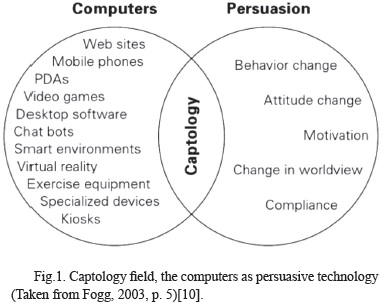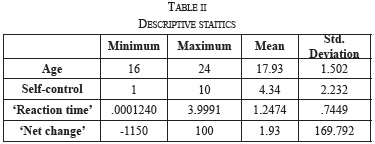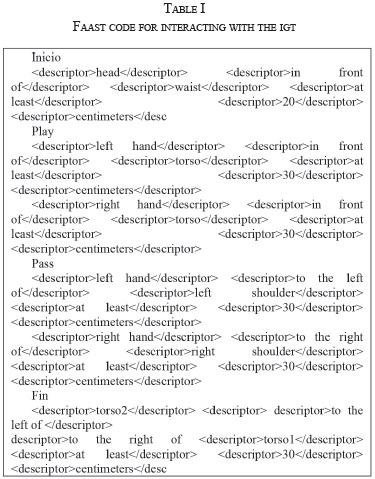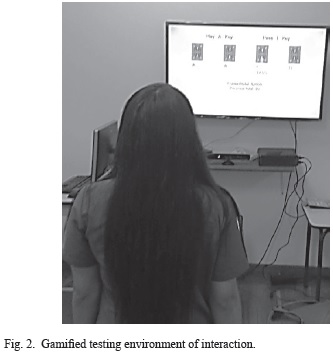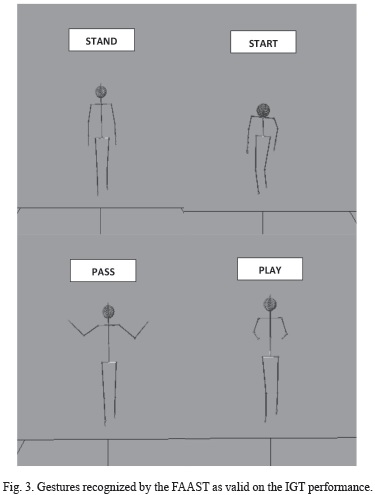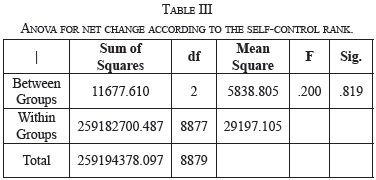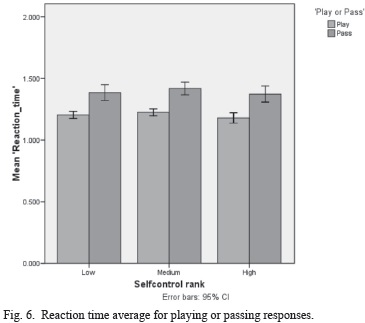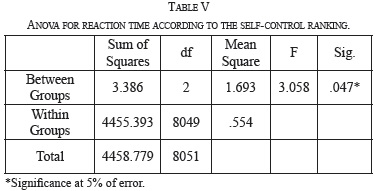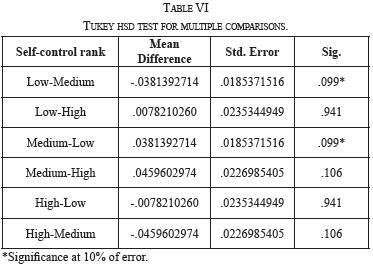Services on Demand
Journal
Article
Indicators
-
 Cited by SciELO
Cited by SciELO -
 Access statistics
Access statistics
Related links
-
 Cited by Google
Cited by Google -
 Similars in
SciELO
Similars in
SciELO -
 Similars in Google
Similars in Google
Share
Entre Ciencia e Ingeniería
Print version ISSN 1909-8367
Entre Ciencia e Ingenieria vol.10 no.20 Pereira July/Dec. 2016
Gamification of a psychological test for assessing students' self-control with Kinect sensor1
Gamificación de una prueba psicológica para la evaluación del autocontrol en estudiantes con el sensor Kinect
Ludificação de uma prova psicológica para a avaliação do autocontrole em estudantes com o sensor Kinect
F. Parrado* y D. Ospina**
1 Producto derivado de los resultados del proyecto de investigación "Entrenamiento de autocontrol con un exergame". Financiado en la convocatoria 013 por la Universidad Católica de Pereira.
* F. Parrado, Psicólogo, Especialista en Psicología del Consumidor, Magister en Estudios Avanzados en Cerebro y Conducta. Investigador del Programa de Psicología Universidad Católica de Pereira. (Colombia); email: felipe.parrado@ucp.edu.co.
** D. Ospina-Toro, Ingeniera de Sistemas y Computación, Magíster en Ingeniería Eléctrica de la Universidad Tecnológica de Pereira, Pereira (Colombia); email: dospina@utp.edu.co.
Recibido Diciembre 03 de 2015 - Aceptado Mayo 30 de 2016
Abstract
The gestures and movement recognition technology might support and improve measurements of psychological constructs as self-control, that it is considered a personality trait or an ability of preferring delayed consequences. Traditionally, their assessment is executed with surveys and performance on specific tasks. In this study selfcontrol was measured with a 16-PF test and the choice pattern was assessed with different values of responses from the Iowa Gambling Task. A sample of 85 students of Psychology played in a human computer interface using the Kinect sensor. It was found that the participants had similar earnings and differential time reaction (F (2, 8049) = 3.058, p < .005) and taking play or pass decisions (p < .001) particularly between low and medium self-control rank. The findings point that the use of sensor Kinect is useful to improve technology for classifying choice performance corresponding to psychological concepts.
Key words: Human Computer Interaction, gamification, serious games, self-control, Iowa Gambling Task, decision making, psychological test.
Resumen
La tecnología de reconocimiento de gestos y movimiento puede soportar y mejorar las mediciones de constructos psicológicos como el autocontrol, el cual es considerado como un rasgo de personalidad o una habilidad para preferir consecuencias demoradas. Tradicionalmente, la evaluación es realizada con encuestas y la ejecución de tareas específicas. En este estudio el autocontrol fue medido con la prueba 16 PF y el patrón de elección fue evaluado con los diferentes valores de respuesta del Iowa Gambling Task. Una muestra de 85 estudiantes de psicología jugaron en una interfaz de humano-computador usando el sensor Kinect. Se encontró que los participantes tuvieron similares ganancias y un tiempo de reacción diferente (F (2, 8049) = 3.058, p < .005) y al tomar decisiones de jugar o pasar (p < .001) particularmente entre quienes puntuaron bajo y medio autocontrol. Estos hallazgos indican que el uso del sensor Kinect es útil para mejorar la tecnología para clasificar la ejecución de elecciones correspondientes a conceptos psicológicos.
Palabras Clave: Interacción Humano-Computador, Gamificación, Videojuegos serios, Autocontrol, Iowa Gambling Task, Toma de decisiones, Prueba psicológica.
Resumo
A tecnologia de reconhecimento de gestos e movimentos pode suportar e melhorar as medições de construtores psicológicos como o autocontrole, o qual é considerado como um rasgo de personalidade ou uma habilidade para preferir consequências demoradas. Tradicionalmente, a avaliação é realizada com pesquisas e a execução de tarefas específicas. Neste estudo o autocontrole foi medido com a prova 16 PF e o padrão de eleição foi avaliado com os diferentes valores de respostas do Iowa Gambling Task. Uma amostra de 85 estudantes de psicologia jogou numa interface de humano- computador usando o sensor Kinect. Encontrou-se que os participantes tiveram similares ganhos e um tempo de reação diferente (F(2, 8049) = 3.058, p < 005) e ao tomar decisoes de jogar ou passar (p<0.001) particularmente entre quem pontuou baixo e médio autocontrole. Estes achados indicam que o uso do sensor Kinect é útil para melhorar a tecnologia para classificar a execução de eleições correspondentes a conceitos psicológicos.
Palavras chave: Interação humano-computador, Ludificação, Videogames sérios, Autocontrole, Iowa Gambling Task, Toma de decisões, Prova Psicológica.
I. INTRODUCCIÓN
Skinner's ideas about man, freedom and causes of behavior are well-founded in the environment [1]. It might be said that all behavior is a choice in a context. The choice and self-control are among the topics of greatest interest for behavioral scientists. Animals develop different patterns of behavior according to specific moments and that is the reason why human behavior tends to vary. According to these variations, the organisms select and evaluate their behavior preferring some conducts in accordance with their effects on the environment. Hence, self-control is defined as a choice of more valuable middle or long-term options over less valuable short-term options [2].
In choice contexts, impulsiveness is considered a contrary concept of self-control, the kinematic analysis define it as the perturbation of a rate of movement [3]. While, self-control is defined as a persistent pattern where extended consequences are preferred instead of the immediate ones; this is not an internal mental state, but it is a skill that can be trained in order to neutralize other competing responses [4]. Selfcontrol facilitates the regulation of thoughts, impulses and attentional processes.
Impulsive people with low self-control exhibit difficulties in the axes I and II of the DSM IV, evincing behavior disorders such as addictions [5]. At the DSM-V, it has been related to emotional and behavioral regulation, ADHD and other developmental disorders [6]. Also, it is considered as kind of personality associated with antisocial behavior [7]. The traditional and intentional ways to fix people's behavioral disorders are mediated by humans, through education or psychotherapy. However, their outcomes are to be in a long term intervention, and they require high skilled people and considerable repeated interaction trials (many years!) to lead successful learning for a specific/limited audience. For this reasons a good behavioral assessment and modification are expensive and unaffordable it is unaffordable to a broad population.
In many processes, reducing costs has been made possible with the use of technology. Indeed, virtual environments may support more students than a real school building with a bit of budget. In consequence, the usage of technology would be the most effective (cost/profit) to change people's behavior. Human Computer Interaction (HCI) provides appropriate paradigms for the study of behavior through the design, implementation and evaluation of interactive technology [8].
The process for influencing others decisions and attitudes is called persuasion. There are six techniques to generate a positive response: reciprocation, consistency, social validation, liking, authority and scarcity [9]. In combination with technologies, pervasive techniques and computers systems shape a new field of study called "Captology" (See Figure 1).
Thus, a persuasive technology is defined as any interactive computing system designed to change people's attitudes and behaviors. The computer systems have many advantages as a tool for behavioral change: a computer is more persistent than human being, offers greater anonymity, manage huge volume of data, uses many modalities (strategies and techniques), it scale easily and goes where humans cannot go or may not be welcome [10].
In this framework, the most promising trend is the gamifying process, which consists in incorporate game elements into non-game system to incentive a user to have so-called game like behavior. It serves to keep user engagement, maintain him/her captive and motivated [11].
Usually, human behavior experiments use computers to display stimuli and record data. Similarly, video game consoles and computers do it; furthermore, they are designed for non-experienced users. For this reason, video games are more recognized than other specialized incentive technology like some psychology laboratory equipment [12].
These systems are developed on a platform of easy access that: (1) permits to manipulate the programming code, and (2) has flexibility in events related to place and time where virtual activities are performed [13].
Specifically, a kind videogames explore learning processes for human well-being, which means they pursue behavior changes through virtual involvements. The videogames for health are characterized for providing intrinsic and authentic motivation, giving autonomy to the participants and promoting learning experiences [14]. With these interventions, it is intended to modify processes mediating the behavior and hence, producing plastic changes in the participants' brain neural networks [15].
According to the Games for Health Project, video games for health may be classified in the following areas:
- Cognitive and emotional health: Improve brain health, cognition or memory through critical reasoning, problem solving, and decision making and planning. Can be used by people with learning disabilities, emotional issues, brain damage and different levels and types of dementia.
- Participatory health: Technology is present in all the aspects of our life thanks to mobile devices, and that includes health. Several mobile applications have been developed [16] so patients can access their health information and participate continuously keeping up with their medications or treatment in an interactive way.
- Rehabilitation games: These games are potentially and precisely effective for the possibility of re-learn movement patterns to regain motor function [17]. The exergames are closely related and they can be used for rehabilitation programs, physical therapy and ocupational programs.
- Medical Education and Training: Using simulated situations for reducing medical errors and subsequent costs. These games are designed for helping physicians, dentist and other clinicians with professional or surgical training.
- Exergaming: Exergames combine exercise with game play [18] for enhancing or maintaining physical fitness, It can be used as therapy for several disabilities or disorders. This is fifth category, and Nintendo, Wii Fit, and Xbox Kinect are the most popular and commercial consoles.
In the last decade, the design of video games for health has taken advantage on clinical settings [19]. But, there is few evidence from systematic studies, which videogames serve as management, diagnostic or educational tools [20]. The main framework to explain how and why behavior variations are due to persuasive technology comes from attitudes and reinforcement theory [21]. Both explanations narrow the learning onto specific context characteristics, but such approaches have been unsuccessful, actually, the user's interactive pattern must not be dismissed [22].
Then, it seems a lack of theoretical development on this research field, even though their potential application in mental health [23], in the individual variations of learning and in the neural change that can be produced with the use of videogames [24]. A proper way to start to face this challenge is to establish solid concepts that can be tested in video games for health. For example, one possible application, it can be made to training decision-making with a real time strategy game. It was observed that in experimental gambling task, the players gained more virtual money and learned how to avoid losses. Despite that, it was not clear how the executive functions was involved to prompt this learning [23].
Another study analyzed motor patterns of children with autism with a PC-based system to study impulsivity. It was found that the impulsive condition was recognized through sudden changes of the movement direction or intensity, corresponding to gestures performed with a deficient preparation [3].
In the university students it was found that, low self-control scores, were linked with predisposition to commit distractive behavior and driving errors of omission and commission [24]. Likewise, impulsivity has been linked to alcohol binge, substance intake [25] and academic failure [26]. In another study, it was found that the self-control score was significantly associated with academic achievements [27].
Reinforcement signaling on videogames or machines for learning may alter the reward value to reduce impulsive behavior pattern [28]. Anderson-Hanley et al. [29] found a relationship between executive functions, self-regulation and exercise behaviors when exergames are employed. Also videogames were designed for learning self-control developing specific attention and memory students' skills [30].
The findings mentioned above provide an interesting tendency about the use of new digital media tools to stimulate self-control changes in different populations. The execution task in all applications should be understood from excitatory and inhibitory mechanisms, which are coordinated to produce action with the motivational value varying over time. With these theoretical basis, we consider important to relate the impulsiveness and self-control, with motor movement and time reaction, because in the previous studies it was not possible to separate attention and learning in a potential motor pattern [31]. To establish this type of relationship would open a new field of experimentation with which it would be possible to suggest new ways of behavior modification through the acquisition and automation of motor movements.
In the present study, to establish a relationship between decision-making and patterns of motor movements has been used the Iowa Gambling Task (IGT) [32], that it has been modified to be performed using exergame dynamics. The elements of the adaptation are presented below which have been developed in clinical and laboratory setting as a behavioral measure of risky decision making.
The player was instructed to maximize their winnings, requiring to determine which deck will lead to long-term gains and which one to long-term losses [33]. The system mimics a uncertainty decision context concerning monetary outcomes, represented by a conflict between the chances of encountering an immediate large reward in two long-term losing decks, and the chances of encountering an immediate small reward in two long-term winning deck [34]. Instead of play a keyboard, participants made decision on IGT with natural gestures.
Natural gesture interaction was possible thanks to kinect´s articulated skeletons [35], which consist of positions and orientations for each joint in a human figure, they are recorded by the Kinect sensor: 20 joints distributed in the human body connected by linear segments. On this basis, Flexible Action and Articulated Skeleton Toolkit (FAAST) enables to use the movements of these segments of the human body as a input to a wide range of applications [36]. It can be employed to emulate keyboard and mouse inputs for standalone PC applications, as well as web-based videogames[37].
The IGT has been adapted using the FAAST to asses movement patterns instead of keyboard or mouse events, so the researcher was able to program specific gestures to evaluate and classify users' behavior [38]. Therefore, it was expected that, the differential task performance according with self-control rank, was given by the score of a personality test.
II. METHODOGY
Participants
The group of participants was university students at Catholic University of Pereira (UCP) in their first or second year of Psychology. The sample was selected by convenience, 85 volunteer students between 16 and 24 years old responded to the calling (58 women and 27 men), they represented the 20% of the students registered in the Psychology program (see table II).
The Ethics committee of the UCP approved this protocol. All participants signed an informed consent to use their data in this study.
Materials
The personality trait self-control students was ranked according to the self-control scale of the 16 PF fifth edition test [39]. The observed scores varied from 1 to 10 (Mean=4.34; SD=2.232) in a scale from 1 to 10. In the data analysis they were grouped in low (1-3) medium (4-6) and high (7-10) self-control according with a previous study [40]; 18.9% of the sample scored in the high level, 44.7% marked in the medium rank and 36.4% recorded as low.
A. Iowa Gambling Task (IGT)
The IGT was developed to simulate real-life financial decisions. In contrast to other task where all the necessary information is available for making decisions, the IGT is based on a long exploratory learning process to evaluate long-term risk anticipation in decision making [41]. The IGT contains elements of contingency-reversal learning where four decks of cards are presented to the participant, each one of them containing cards with rewards or punishments by adding or subtracting points or amounts of money from their account. Two of the decks (C and D) lead to net increases over the course of repeated play while the other two decks lead to net losses (A and B). After each choice, the system showed the amount earned or lost. The users had four seconds to make a choice (play or pass) over the deck marked by the system, there were 120 trials balanced in 6 blocks of 20 essays. The IGT program used in this study was written in Matlab based on the Psychtoolbox extensions [42].
B. FAAST: Flexible Action and Articulated Skeleton Toolkit
FAAST is a depth-sensing framework that enables to use full-body tracking with the Kinect sensor to program applications with gesture inputs [43]. Gestures can be customized to fit the needs of each individual user. FAAST considers two broad categories of cinematic information from the sensor: actions and articulated skeletons. Procedure
In order to apply the IGT in a consistent way related with exergames playability, the keyboard events -start, play and pass where switched to gesture events thanks to the FAAST tool with the coding show at the table I. The assessment methodology of the IGT test requires the use of three events, selected according to two criteria where they must be: (1) easily learned to avoid interaction confusions and (2) sufficiently differentiable in order to avoid gesture recognition errors (related with false detections and false inhibitions).
After a short introduction about the interaction dynamics, each student started the test alone in a resting state as Figure 2 shows. As it is shown in the Figure 3, to start the IGT the user should perform a reverence.
On the task, the user may perform two gestures for choosing: Shoot for playing with the marked card, where the user put their hands in front of their trunk at least 30 cm; the second gesture, the pass event where the user put both hands up at least 30 cm aside from each shoulder (See Table I, and figure 3).
Once the IGT-gesture test initiated, the user could choose, in each trial, between play and pass performing with both hands. The test finalized after 120 trials in 12 minutes as maximum. Each trial took 4 seconds at least, and responses out of this time were considered omissions. Trials where users performed an omission did not have record of reaction time. If player's choices were play, the players were taking a risk for gaining or losing some virtual money; but if player choices were pass, the amount earned through the task remained without changes. The data related to the reaction time ('Reaction time'), changes on virtual money earned ('Net change') and choices ('Play', 'Pass', 'Omission') on the IGT was collected for all the users, as well as their scores in the self-control 16PF scale.
III. RESULTS
The system implemented with sensor Kinect and the FAAST had a sensibility of .0001 seconds to record user's response latency; the participants experimented a maximum reward of 100 and a penalties until 1150. The scores of self-control varied in the whole personality scale, with a mean of 4.34 and standard deviation of 2.232 (see table II).
As it is described in the procedure, each deck had different outcomes for playing choice. In average the participants lost money 17.2 at choosing A and 10 in the B deck; they earn 16.3 at C and 25.8 in D deck. There was more variability at playing the disadvantageous options, particularly in B option, in comparison with the decks C and D (See Figure 4).
Perhaps the observed differences in means and dispersion of the amount virtual money earned –Net change- showed in the figure 4, this do not correspond with self-control rank. In fact the table III shows that the variance analysis showed no meaningful (p > .005) difference for net change according with self-control rank scored (See Table III). So, the selfcontrol is not being classified by the 'net change' on each trial of the task. For this reason, this variable is excluded in the following statistical analysis.
It was analyzed the rate of choice according the selfcontrol rank; the Figure 5 shows the percentage of responses (playing, passing and omissions) considering the selfcontrol rank. Participants with low self-control performed less passing choices (29.4%) than playing (38.2%), and they exhibit the highest rate omissions (41.5%) on the IGT. The group of medium self-control rank had the highest rate of playing (49.8%), followed by 43.3% in passing and 39.9% of omissions. In contrast, the group with high self-control performed less playing (18.3%), passing (20.8%) and omissions (18.6%) on the IGT.
That difference may be due to sample size and the distribution of self-control scores described in the methodology. But the tendency observed in the Figure 5 was confirmed with chi-square test (see Table IV), the percentage of choices is narrow to self-control (P < .001; df=4).
(a) 0 cells (0%) have expected count less than 5. The minimum expected count is 11.19.
By other hand, the reaction time had few variability according self-control rank (see the Figure 6). The Low rank played at 1.203 sec, the group of medium rank at 1.225 and the group with high self-control at 1.179. Whereas, the passing choices spent more time, low rank had 1.384, medium rank 1.418 and high 1.373 seconds in average.
It seems that all participants had the same latency mean for playing or passing through the self-control ranks. But the ANOVA test revealed meaningful differences in time reaction (p < .005) (See Table V) and a Tukey HSD test post-hoc showed difference (p < .1) between the Low and Medium self-control groups (See Table VI).
Allowing this statistical analysis, the major difference in the reaction time of performance recorded by the Kinect sensor on the IGT happened among the students with low selfcontrol. Their mean difference was positive, it points that students ranked with low self-control are slower than other students in the task.
IV. DISCUSSION AND CONCLUSIONS
In the IGT, individuals experience rewards and punishments as they select from four card decks: A, B, C, D. Deck A and B are ‘bad decks' that have high immediate rewards ($100 per draw) and larger comparative punishments. Deck C and D are ‘good decks' [44].
A previous research had compared the performance on five versions of the IGT, virtual and real, it demonstrated that the use of virtual cards alone did not result in optimal performance in college-age participants. IGT procedures that employed both real and virtual cards yielded significantly higher scores in two measures of performance: (1) choice of advantageous cards across 100 trials was significantly higher with the use of real/virtual cards, and (2) the difference was more pronounced when examining performance later blocks of the task [45].
Also, preceding studies have found a relation between the IGT and trait impulsivity [46] [47], but they were focused on the analysis in decks selection. Following the literature, it seems that risky selections in the IGT reflect propensity for risk seeking. Participants may develop an explicit knowledge of the IGT risks after a long period of learning. Players appeared to reduce preference for deck B and increase choices from deck C (B), while Non-learners did not appear to reduce deck B preference. This bias is partially confirmed with the results observed in the Figure 4.
In this study, we explored the gamification of the IGT as a psychological test for assessing self-control using the Kinect sensor. Different to previous studies with other methodologies [44-47], here the outcomes of winning or losing are not related with self-control. The results in this study show that the group with low self-control has a high number of omissions respect to medium self-control group. As well, there are significant difference in latency and distribution of choices in decision-making among the ranks of self-control. There is a clear evidence of the validity of the gamified IGT to classify actions for assessing self-control.
The IGT version conducted here induce to player to take strategically actions for managing risk and attention, similar to Go/No-go essays of neuropsychological tasks for attention. Thereby, it would be consider the time as a valuable resource, the psychological currency. The difference in latencies between low and medium self-control rank would reflect regulation of motor and cognitive skills, personality trait or simply a learning process. In future studies, it will be interesting to analyze the velocity and accelerations of movements for taking a regulated decision, playing or passing, as well how to figure out the omissions registered.
The participants that had a high level of self-control showed a reduction of more than half of the omissions percentage and learned how to choose faster the decisions of pass and play. Previous studies have found that a relatively short videogame intervention could result in dramatic improvements of a number of perceptual and cognitive abilities [48].
It might be noticed that the outcome of the IGT score depends on the balance between exploration and exploitation behaviors reflected in the playing and passing response pattern. The participants should discover the best option after exploring several of them and however, the number of trials is limited. The results point that the students left the exploration phase (omission responses) to commit responses (playing or passing) in the task. There are very important factors in the use of exergames as a powerful tool to engage users in testing settings [49].
The increase of emotional self-control skills through the use of exergames inside the campus should certainly be a positive option, especially because self-controlled students have higher correlations with higher scores, showing that low self-control is thus a significant risk factor for a broad range of personal and interpersonal problems in college student's context [50].
Educational settings might include technology to build a persuasive ambient [51], where users might be aware about their own and others mobility behavior, with real time and accumulated consequences feedback.
By tradition the assessment of user's behavior has been done mainly through surveys. But the decision making process is anchored to a particular -informational and emotional- remembered experience. The perceptions as sum of this set of experiences and its valuations -considered as attitudes- are not enough to predict behaviors as engagement or commitment in education or health settings, due to these concepts are referred to effective actions.
It is well know that people does not consider whole information to make decisions. There is a gap between liking and wanting. Instead of a complicated informational process, the choices are resulting of simple heuristics [52] or rules of thumb [53]; which combine emotions and pieces of experience to produce fast and easy response to everyday problems. Most behaviors are not mediated by language or consciousness, that is because we take not perfect but good automatic decisions.
The behavioral approach avoids this obstacle by going directly over people's environment and behavior; for this case, it would be more fruitful to assess user's actions on its particular settings further survey's applications. For the user will be a challenge take decisions instead of just to ask him/ her about it.
In this manner, to direct behavioral change for education, it would be implemented the classificatory method stated by Fogg and Hreha [54]; in which different mobility behavior are organized according to its initial frequency and knowledge. Behaviors are classified according to its rate and familiarity for the participants.
This kind of systems have been successful in other fields (i.e. transport, health promotion) due to people fits behavior better to exteroceptive stimuli than proprioceptive stimuli [55] and they are persuaded easily in the presence of signals In summary, exergames seem very promising and affordable tools for assessing and training self-control within a simulated context to transfer it into natural environments of clinical and normal population. The sensor Kinect is an affordable tool to adapt natural performance [57] for computerized assessing of decision making process with a high reliability.
Videogame-based evaluations and interventions may hold promise in terms of addressing academic declines associated with low levels of self-control, but there are still many unknowns. Important features related with self-confidence and self-control are associated with certain motor patterns that can be trained in a funny and engaged way through the use of commercial and specialized exergames. At this point, researchers must recognize individual differences in game preference between children, high school students and university students, in order to structure and deliver different interventions to ensure people engage in them [58].
For future work, the use of the motion capture (MoCap) data recorded from the Kinect sensor for each the IGTmodified interaction is proposed. The System Dynamics Theory (SDT) [59] would be useful for representing graphically kinematic data in order to extract movement patterns related with coordination. The relative phase plane has been found to be the variable that best expresses coordination changes in a wide range of biological phenomena, including human movement [60].
ACKNOWLEDGMENTS
The authors recognize the helpful advices and comments by PhD Oscar Henao in the "Human Computer Interaction Group".
REFERENCES
[1] B. F. Skinner and M. J. Gallofré, Ciencia y conducta humana: Fontanella Barcelona, 1974. [ Links ]
[2] H. Rachlin, "Self-control: Beyond commitment," Behavioral and Brain Sciences, vol. 18, pp. 109-121, 1995. [ Links ]
[3] S. Piana, A. Staglianò, A. Camurri, and F. Odone, "A set of Full-Body Movement Features for Emotion Recognition to Help Children affected by Autism Spectrum Condition," in IDGEI International Workshop, 2013. [ Links ]
[4] H. C. Miller, K. F. Pattison, C. N. DeWall, R. Rayburn-Reeves, and T. R. Zentall, "Self-control without a "self"? Common self-control processes in humans and dogs," Psychological Science, 2010. [ Links ]
[5] R. J. Huntjens, M. M. Rijkeboer, A. Krakau, and P. J. de Jong, "Implicit versus explicit measures of self-concept of self-control and their differential predictive power for spontaneous trait-relevant behaviors," Journal of behavior therapy and experimental psychiatry, vol. 45, pp. 1-7, 2014. [ Links ]
[6] A. P. Association, Diagnostic and statistical manual of mental disorders (DSM-5®): American Psychiatric Pub, 2013. [ Links ]
[7] J. M. Low, D. Williamson, and J. Cottingham, "Predictors of university student lawbreaking behaviors," Journal of College Student Development, vol. 45, pp. 535-548, 2004. [ Links ]
[8] B. A. Schouten, R. Tieben, A. van de Ven, and D. W. Schouten, "Human behavior analysis in ambient gaming and playful interaction," in Computer Analysis of Human Behavior, ed: Springer, 2011, pp. 387-403. [ Links ]
[9] R. Cialdini, "The science of persuasion," Scientific American, vol. 284, p. 7, 2003. [ Links ]
[10] B. Fogg, Persuasive Technology: Using Computers to Change what We Think and Do. Boston: Morgan Kaufmann, 2003. [ Links ]
[11] Y. Liu, T. Alexandrova, and T. Nakajima, "Gamifying intelligent environments," in Proceedings of the 2011 international ACM workshop on Ubiquitous meta user interfaces, 2011, pp. 7-12. [ Links ]
[12] L. E. Nacke, "An introduction to physiological player metrics for evaluating games," in Game Analytics, ed: Springer, 2013, pp. 585-619. [ Links ]
[13] T. Baranowski, R. Buday, D. Thompson, E. J. Lyons, A. S. Lu, and J. Baranowski, "Developing games for health behavior change: Getting started," GAMES FOR HEALTH: Research, Development, and Clinical Applications, vol. 2, pp. 183-190, 2013. [ Links ]
[14] R. Malaka, "How Computer Games Can Improve Your Health and Fitness," in Games for Training, Education, Health and Sports, ed: Springer, 2014, pp. 1-7. [ Links ]
[15] A. B. Fagundo, J. J. Santamaría, L. Forcano, C. Giner-Bartolomé,‐ S. Jiménez Murcia, I. Sánchez, et al., "Video Game Therapy for Emotional Regulation and Impulsivity Control in a Series of Treated Cases with Bulimia Nervosa," European Eating Disorders Review, vol. 21, pp. 493-499, 2013. [ Links ]
[16] M. N. K. Boulos, S. Wheeler, C. Tavares, and R. Jones, "How smartphones are changing the face of mobile and participatory healthcare: an overview, with example from eCAALYX," BioMedical Engineering OnLine, vol. 10, pp. 24-24, 04/05. [ Links ]
[17] M. D. J. McNeill, D. K. Charles, J. W. Burke, J. H. Crosbie, and S. M. McDonough, "Evaluating user experiences in rehabilitation games," Journal of Assistive Technologies, vol. 6, pp. 173-181, // 2012. [ Links ]
[18] A. E. Staiano and S. L. Calvert, "Exergames for Physical Education Courses: Physical, Social, and Cognitive Benefits," Child Development Perspectives, vol. 5, pp. 93-98, 2011. [ Links ]
[19] H. Kharrazi, A. S. Lu, F. Gharghabi, and W. Coleman, "A Scoping Review of Health Game Research: Past, Present, and Future," Games for Health Journal, vol. 1, pp. 153-164, 2012/04/01 2012. [ Links ]
[20] E. Rahmani and S. A. Boren, "Videogames and Health Improvement: A Literature Review of Randomized Controlled Trials," Games for Health Journal, vol. 1, pp. 331-341, 2012/10/01 2012. [ Links ]
[21] H. Oinas-Kukkonen, "Behavior Change Support Systems: A Research Model and Agenda," in Persuasive Technology: 5th International Conference, PERSUASIVE 2010, Copenhagen, Denmark, June 7-10, 2010. Proceedings, T. Ploug, P. Hasle, and H. Oinas-Kukkonen, Eds., ed Berlin, Heidelberg: Springer Berlin Heidelberg, 2010, pp. 4-14. [ Links ]
[22] L. Obando and F. Parrado, "Aproximaciones conductuales de primera, segunda y tercera generación frente a un caso de ludopatía," Revista Iberoamericana de Psicología: Ciencia y Tecnología, vol. 8, pp. 51-61, 2015. [ Links ]
[23] C. Bosch, J. Miranda, M. Sangiorgio, I. Acuña, Y. Michelini, L. Marengo, et al., "Efecto del entrenamiento con un juego de estrategia en tiempo real sobre la toma de decisiones en adolescentes," PSIENCIA. Revista Latinoamericana de Ciencia Psicológica, vol. 8, p. 19, 2016. [ Links ]
[24] A. I. Ferreira, L. F. Martínez, and M. A. Guisande, "Comportamiento de riesgo, rasgos de personalidad y accidentes de carretera en estudiantes universitarios," 2015, vol. 2, 2015-10-29 2015. [ Links ]
[25] A. Adan, "Impulsividad funcional y disfuncional en jóvenes con consumo intensivo de alcohol (binge drinking)," Adicciones, vol. 24, pp. 17-22, 2012. [ Links ]
[26] A. L. Duckworth and S. M. Carlson, "Self-regulation and school success," Self-regulation and autonomy: Social and developmental dimensions of human conduct, vol. 40, p. 208, 2013. [ Links ]
[27] S. Newsome, A. L. Day, and V. M. Catano, "Assessing the predictive validity of emotional intelligence," Personality and Individual Differences, vol. 29, pp. 1005-1016, 2000. [ Links ]
[28] R. Shao, J. Read, T. E. J. Behrens, and R. D. Rogers, "Shifts in reinforcement signalling while playing slot-machines as a function of prior experience and impulsivity," Transl Psychiatry, vol. 3, p. e213, 01/15/online 2013. [ Links ]
[29] C. Anderson-Hanley, P. J. Arciero, N. Barcelos, J. Nimon, T. Rocha, M. Thurin, et al., "Executive function and self-regulated exergaming adherence among older adults," Frontiers in human neuroscience, vol. 8, 2014. [ Links ]
[30] R. Kulman, G. Stoner, L. Ruffolo, S. Marshall, J. Slater, and A. Dyl, "Teaching executive functions, self-management, and ethical decision-making through popular videogame play," 2010. [ Links ]
[31] S. Palacio, J. Villa, F. Parrado, and M. Rosero, "Modulación estrogénica de la toma de decisiones arriesgadas," Textos y Sentidos, vol. 10, pp. 175-193, 2014. [ Links ]
[32] M. Buelow and J. Suhr, "Construct Validity of the Iowa Gambling Task," Neuropsychology Review, vol. 19, pp. 102-114, 2009/03/01 2009. [ Links ]
[33] E. Cauffman, E. P. Shulman, L. Steinberg, E. Claus, M. T. Banich, S. Graham, et al., "Age differences in affective decision making as indexed by performance on the Iowa Gambling Task," Developmental psychology, vol. 46, p. 193, 2010. [ Links ]
[34] R. Van den Bos, W. Lasthuis, E. Den Heijer, J. Van der Harst, and B. Spruijt, "Toward a rodent model of the Iowa gambling task," Behavior research methods, vol. 38, pp. 470-478, 2006. [ Links ]
[35] B. Lange, C. Y. Chang, E. Suma, B. Newman, A. S. Rizzo, and M. Bolas, "Development and evaluation of low cost game-based balance rehabilitation tool using the microsoft kinect sensor," in 2011 Annual International Conference of the IEEE Engineering in Medicine and Biology Society, 2011, pp. 1831-1834. [ Links ]
[36] B. Lange, A. Rizzo, C.-Y. Chang, E. A. Suma, and M. Bolas, "Markerless full body tracking: Depth-sensing technology within virtual environments. [ Links ]"
[37] S. Escalera, "Human behavior analysis from depth maps," in Articulated Motion and Deformable Objects, ed: Springer, 2012, pp. 282-292. [ Links ]
[38] E. A. Suma, D. M. Krum, B. Lange, S. Koenig, A. Rizzo, and M. Bolas, "Adapting user interfaces for gestural interaction with the flexible action and articulated skeleton toolkit," Computers & Graphics, vol. 37, pp. 193-201, 2013. [ Links ]
[39] R. B. Cattell and H. E. P. Cattell, "Personality Structure and the New Fifth Edition of the 16PF," Educational and Psychological Measurement, vol. 55, pp. 926-937, 1995. [ Links ]
[40] A. Aluja and A. Blanch, "Análisis descriptivo y comparativo del 16PF-5 en muestras americanas y españolas," Boletín de Psicología (Valencia), pp. 27-38, 2002. [ Links ]
[41] H. Fukui, T. Murai, H. Fukuyama, T. Hayashi, and T. Hanakawa, "Functional activity related to risk anticipation during performance of the Iowa Gambling Task," Neuroimage, vol. 24, pp. 253-259, 2005. [ Links ]
[42] M. Kleiner, "Visual stimulus timing precision in Psychtoolbox-3: Tests, pitfalls and solutions," Perception ECVP abstract, vol. 39, pp. 189-189, 2010. [ Links ]
[43] E. A. Suma, B. Lange, A. Rizzo, D. M. Krum, and M. Bolas, "Faast: The flexible action and articulated skeleton toolkit," in Virtual Reality Conference (VR), 2011 IEEE, 2011, pp. 247-248. [ Links ]
[44] C. J. Seeley, R. J. Beninger, and C. T. Smith, "Post Learning Sleep Improves Cognitive-Emotional Decision-Making: Evidence for a 'Deck B Sleep Effect' in the Iowa Gambling Task," PLoS ONE, vol. 9, p. e112056, 2014. [ Links ]
[45] W. H. Overman and A. Pierce, "Iowa Gambling Task with non-clinical participants: effects of using real + virtual cards and additional trials," Frontiers in Psychology, vol. 4, p. 935. [ Links ]
[46] D. J. Upton, A. J. Bishara, W.-Y. Ahn, and J. C. Stout, "Propensity for risk taking and trait impulsivity in the Iowa Gambling Task," Personality and Individual Differences, vol. 50, pp. 492-495, 4// 2011. [ Links ]
[47] M. T. Buelow and J. A. Suhr, "Personality characteristics and state mood influence individual deck selections on the Iowa Gambling Task," Personality and Individual Differences, vol. 54, pp. 593-597, 4// 2013. [ Links ]
[48] E. B. Larson, M. Feigon, P. Gagliardo, and A. Y. Dvorkin, "Virtual reality and cognitive rehabilitation: A review of current outcome research," NeuroRehabilitation, 2014. [ Links ]
[49] T. Baranowski, R. Buday, D. I. Thompson, and J. Baranowski, "Playing for real: video games and stories for health-related behavior change," American journal of preventive medicine, vol. 34, pp. 74-82. e10, 2008. [ Links ]
[50] J. P. Tangney, R. F. Baumeister, and A. L. Boone, "High selfcontrol predicts good adjustment, less pathology, better grades, and interpersonal success," Journal of personality, vol. 72, pp. 271-324, 2004. [ Links ]
[51] T. Nakajima and V. Lehdonvirta, "Designing motivation using persuasive ambient mirrors," Personal and ubiquitous computing, vol. 17, pp. 107-126, 2013. [ Links ]
[52] D. Kahneman, "Thinking," Fast and Slow, Farrar, Straus and Giroux, 2011. [ Links ]
[53] G. Gigerenzer, Gut feelings: The intelligence of the unconscious: Penguin, 2007. [ Links ]
[54] B. Fogg and J. Hreha, "Behavior wizard: A method for matching target behaviors with solutions," in Persuasive Technology, ed: Springer, 2010, pp. 117-131. [ Links ]
[55] G. M. Rodríguez, G. A. García, D. M. Gutiérrez, F. V. Pérez, and Z. C. Bohórquez, "[Competence between propioceptive and exteroceptive conditional stimuli in a conditional discrimination task]," Psicothema, vol. 21, pp. 390-396, 2009. [ Links ]
[56] U. R. Karmarkar and Z. L. Tormala, "Believe me, I have no idea what I'm talking about: The effects of source certainty on consumer involvement and persuasion," Journal of Consumer Research, vol. 36, pp. 1033-1049, 2010. [ Links ]
[57] M. Martínez-Zarzuela, F. Díaz-Pernas, A. Tejeros-de-Pablos, D. González-Ortega, and M. Antón-Rodríguez, "Action recognition system based on human body tracking with depth images," Advances in Computer Science: an International Journal, vol. 3, pp. 115-123, 2014. [ Links ]
[58] W. R. Boot, M. Champion, D. P. Blakely, T. Wright, D. J. Souders, and N. Charness, "Video games as a means to reduce age-related cognitive decline: attitudes, compliance, and effectiveness," Frontiers in psychology, vol. 4, 2013. [ Links ]
[59] R. Angulo-Barroso, A. Busquets Faciabén, and E. Mauerberg de Castro, "El retrato de fase como una herramienta de análisis del comportamiento motor," Apuntes. Educación física y deportes, pp. 49-61, 2010. [ Links ]
[60] R. Bartlett, Introduction to sports biomechanics: Analysing human movement patterns: Routledge, 2007. [ Links ]
Felipe Parrado Corredor. Nació en Bogotá, D.C, Colombia. Es docente de tiempo completo del programa de Psicología de la Universidad Católica de Pereira-UCP. Es integrante de la línea en Neurociencia y Conducta del grupo de investigación "Clínica y Salud Mental". Sus principales intereses de investigación son el aprendizaje de relaciones y la toma de decisiones.
Daniela Ospina Toro, graduada como Ingeniero de Sistemas y Computación de la Universidad Tecnológica de Pereira, analizó los ritmos de la actividad neuronal de niños con déficit de atención en su tesis de Magister en Ingeniería Eléctrica de la Universidad Tecnológica de Pereira. Ha sido joven investigadora de Colciencias. Sus principales intereses de investigación son la Neurociencia computacional y el estudio de la conciencia.













